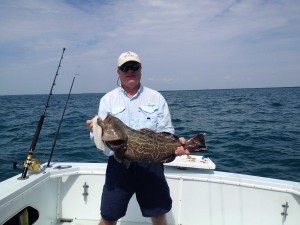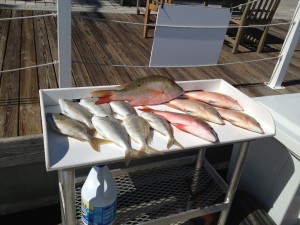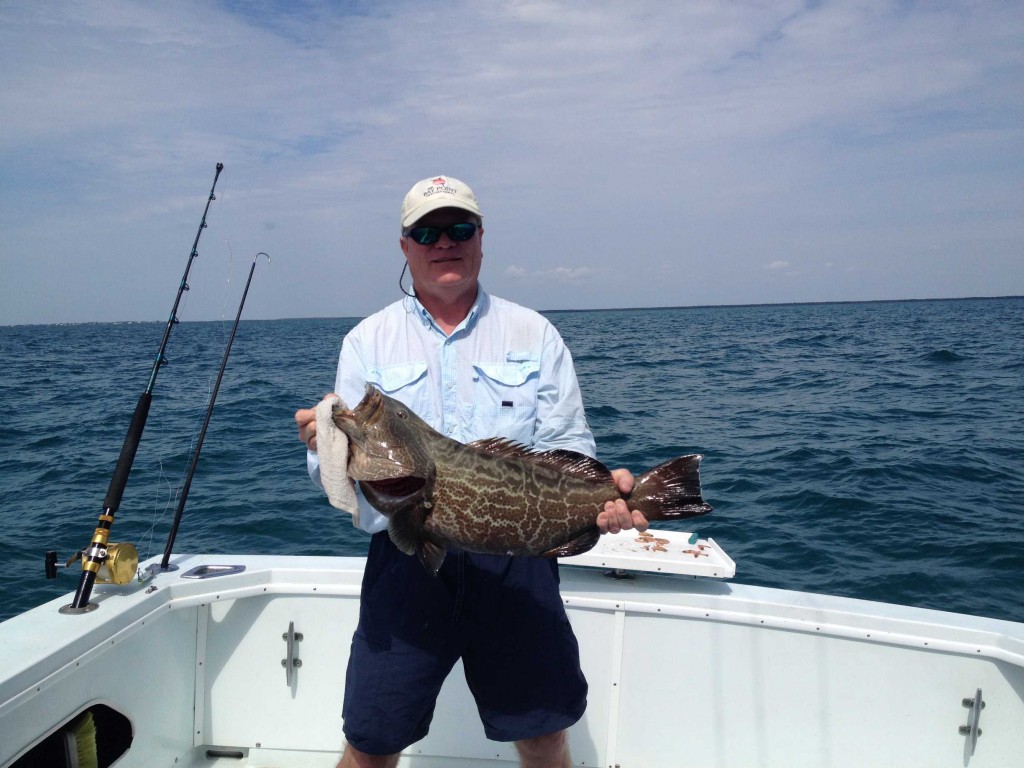Offshore Bottom Fishing Tactics
By Capt. Charlie Beadon
 There are so many different ways to catch fish; from inshore sight casting to offshore trolling, but somewhere in the middle lies the most addictive of all…big game bottom fishing. When we refer to offshore bottom fishing in South Carolina we are generally talking about fishing baits on the bottom 20 or more miles offshore in waters from 50 to 600 feet deep. The most exciting part of this fishery is that you never know what or how big your next fish is going to be. When you make a drop you may come up with a half pound sea bass or be pinned to the rail by a 30 pound grouper. Moreover, these fish are not only great fun to catch but many bottom fish make for great table fare.
There are so many different ways to catch fish; from inshore sight casting to offshore trolling, but somewhere in the middle lies the most addictive of all…big game bottom fishing. When we refer to offshore bottom fishing in South Carolina we are generally talking about fishing baits on the bottom 20 or more miles offshore in waters from 50 to 600 feet deep. The most exciting part of this fishery is that you never know what or how big your next fish is going to be. When you make a drop you may come up with a half pound sea bass or be pinned to the rail by a 30 pound grouper. Moreover, these fish are not only great fun to catch but many bottom fish make for great table fare.
First, let’s look at our target species. Most bottom fish can be broken down into the following categories: Snapper, Grouper, Jacks, Mackerel and Cobia. There are many other fish out there, but today were going to place emphasis on these select groups. The Snappers will include red, vermilion, lane and gray snapper. These fish are all great eating and fun to catch. The Groupers will include black, gag, red, and scamp grouper. These are also great eating fish and are noted for their explosive bites and powerful digs to the bottom. The jacks will include crevalle, almaco and amber jacks. Jacks are edible, but only the almaco jack is worth taking home. The jacks some of the best fighting fish in the ocean…if your looking for something big and mean to pull on then look no further than the jack family. Mackerel and cobia both stand alone. They are both great fighting fish and the cobia is great eating whereas the mackerel is only fair.
Next were going to focus on offshore bottom fishing tackle. In general, most of your bottom fishing tackle will be relatively stout. I generally use 20 to 50 pound class rods, reels and braided line. Braided line is important in bottom fishing because it not only allows you to feel the bite but also has zero stretch which helps you keep big fish under control as they dig hard for the bottom. For most bottom fishing applications I use 40 to 80 pound leader and I always use 4/0-6/0 circle hooks with natural bait. In addition I carry an assortment of barrel swivels, 2-8 ounce egg sinkers, jigs, sabiki rigs, squid rigs and chicken rigs(multiple hook rigs).
 Let’s get into the heart of this discussion and look at various bottom fishing techniques. I’ve broken this section down into two classes; drift or anchor fishing and dead bait, live bait or jig fishing. When you get out there you need to decide weather you’re going to drop the hook and fish on anchor or drift. Anchoring can be very effective when the fish are concentrated in a small area especially if you use chum to draw them to your boat. I generally drift fish, especially when the fish are scattered over a large area. If the wind and current are light drift fishing can be as easy as taking the boat out of gear and dead drifting over a particular area. This style of fishing becomes more difficult when the wind and currents pick up. To effectively drift in these conditions you may chose to power drift (use the motors to assist you) or put out a sea anchor. Once you set anchor or a drift you need to decide upon weather you’re going to dead bait, live bait or use lures. Dead baiting is the easiest for most people because you simply buy the bait (usually Spanish sardines, cigar minnows, mullet, menhaden or ballyhoo) form the tackle store and you’re in business. Rigging is easy; simply use a Carolina rig with a 2-4 foot leader. Dead baiting can be very effective from anchor or when you are making a very slow drift. The key to using dead bait is to allow the bait to lay flat on the bottom as it naturally would when dead. Live baiting requires a little more time and effort in catching and keeping the bait, but can be deadly effective. Most live bait (Spanish sardines, cigar minnows, and blue runners) can be caught using #6 to #8 sabiki rigs and kept alive in a good recirculating live well. I prefer to use live bait when drift fishing because the bait is pulled over the fish (rather than lying on the bottom) usually resulting in a strike. I change my Carolina rig slightly when live baiting by increasing the leader length to 8-15 feet. The last style of bottom fishing that we are going to discuss is the use of jigs. There are several different types of jigs that we use depending on what kind of fish you’re targeting. For larger fish such as grouper, amberjacks, cobia and red snapper I use large buck tail jigs, buck tails with bait and butterfly jigs. For smaller fish such as vermilion snapper and sea bass a squid rig works well.
Let’s get into the heart of this discussion and look at various bottom fishing techniques. I’ve broken this section down into two classes; drift or anchor fishing and dead bait, live bait or jig fishing. When you get out there you need to decide weather you’re going to drop the hook and fish on anchor or drift. Anchoring can be very effective when the fish are concentrated in a small area especially if you use chum to draw them to your boat. I generally drift fish, especially when the fish are scattered over a large area. If the wind and current are light drift fishing can be as easy as taking the boat out of gear and dead drifting over a particular area. This style of fishing becomes more difficult when the wind and currents pick up. To effectively drift in these conditions you may chose to power drift (use the motors to assist you) or put out a sea anchor. Once you set anchor or a drift you need to decide upon weather you’re going to dead bait, live bait or use lures. Dead baiting is the easiest for most people because you simply buy the bait (usually Spanish sardines, cigar minnows, mullet, menhaden or ballyhoo) form the tackle store and you’re in business. Rigging is easy; simply use a Carolina rig with a 2-4 foot leader. Dead baiting can be very effective from anchor or when you are making a very slow drift. The key to using dead bait is to allow the bait to lay flat on the bottom as it naturally would when dead. Live baiting requires a little more time and effort in catching and keeping the bait, but can be deadly effective. Most live bait (Spanish sardines, cigar minnows, and blue runners) can be caught using #6 to #8 sabiki rigs and kept alive in a good recirculating live well. I prefer to use live bait when drift fishing because the bait is pulled over the fish (rather than lying on the bottom) usually resulting in a strike. I change my Carolina rig slightly when live baiting by increasing the leader length to 8-15 feet. The last style of bottom fishing that we are going to discuss is the use of jigs. There are several different types of jigs that we use depending on what kind of fish you’re targeting. For larger fish such as grouper, amberjacks, cobia and red snapper I use large buck tail jigs, buck tails with bait and butterfly jigs. For smaller fish such as vermilion snapper and sea bass a squid rig works well.
In such a vast ocean looking for fish that you can’t see in deep water can seem overwhelming, but there are a lot of things to look for in finding bottom fish. First, a good GPS and sonar are a must; moreover you need to know how to properly use your electronics for them to be effective. Before I even hit the water I spend hours hunched over a good off shore chart looking for bottom structure that I think will hold fish. Good bottom structure will include; ledges, hard or rocky bottom, live bottom, and wrecks. Once I pick out a few good spots I copy the latitude and longitude numbers and check each spot using my sonar, the marks that I am looking for are good undulating bottom, bait and the fish themselves. The key here is to save the spots that are productive so that you can go back and fish them later.
In closing we need to examine bottom fishing rules and regulations. The guidelines set forth by the Department of Natural Resources can be difficult to understand so let’s define general terms to keep you in good graces with jonnie law dog.
State waters: waters inside of 3 miles from shore
Federal waters: waters outside of 3 miles from shore
Closed season: a period of time when you can not keep a particular species
Size limit: the measured length that the fish must be to keep
Total length: the fish is measured from the tip of the nose to the tip of the tail
Fork length: the fish is measured form the tip of the nose to the fork in the tail
Slot limit: to keep the fish it must fall between a minimum and a maximum length
Per person bag limit: the maximum number of a particular species that can be kept per day for each person on the boat
Per boat bag limit: the maximum number of a particular species that can be kept per day for the entire boat
Aggregate limit: A combination of multiple species of fish put together in a single bag limit
It is always good practice to keep a ruler and a copy of updated regulations on the boat for reference. Good luck and tight lines.
Captain Charlie Beadon

